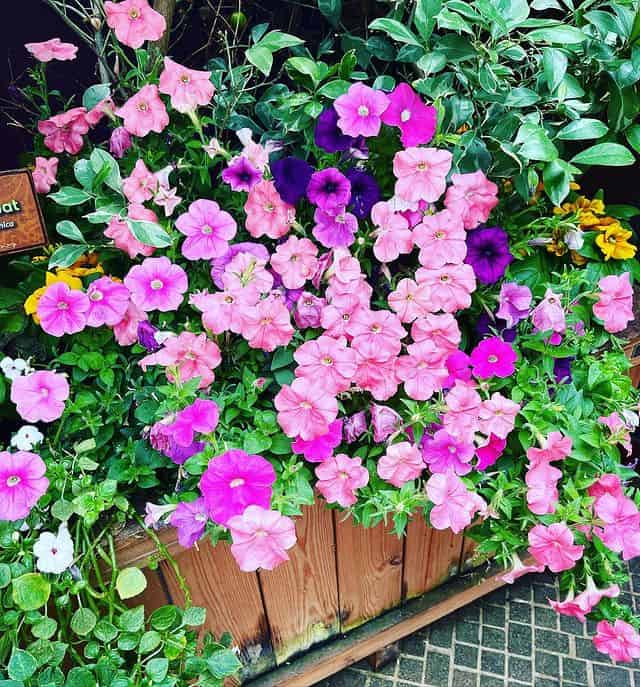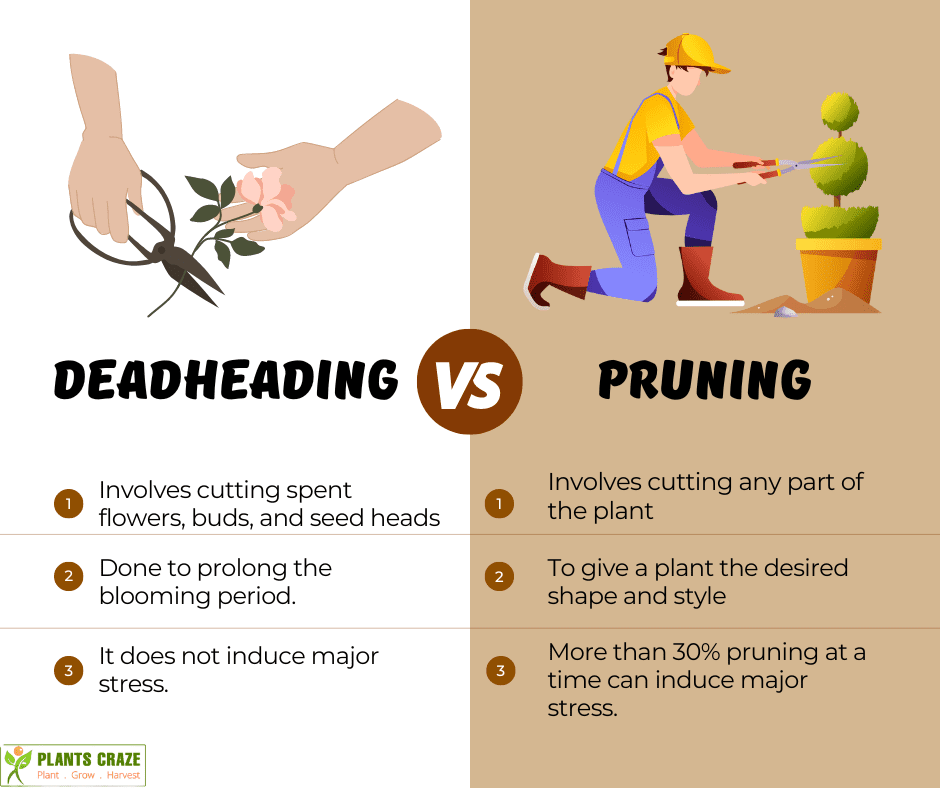Deadheading is an integral part of overall plant and flower care.
Read this article until the end to learn how you can also enjoy the benefits of deadheading.
Table of Contents Show
What is Deadheading a Plant?
Deadheading is a process of removing flowers that have lost their charm right before they send signals for seed formation.
Plants consume a tremendous amount of energy for seed formation.

Hence, plants that are mainly grown for foliage often need deadheading to encourage better flowers and leaves.
The deadheading process is simple because you can deadhead spent flowers by pinching them off at the bottom.
Similarly, you can also use sterilized pruners to deadhead the plant for a clean cut.
Here is a table of some plants that do and don’t need deadheading.
| Need Deadheading | No Need of Deadheading |
|---|---|
| Daffodil | Vinca |
| Petunia | Begonias |
| Cosmos | Nemesia |
| Sunflower | Impatiens |
| Marigolds | New Guinea Impatiens |
| Orchid | Lantana |
Difference Between Deadheading and Pruning
Let us look at the basic differences between deadheading and pruning.

Your Raspberry garden, our article on pruning them. Perfect match, isn’t it?
What is the Point of Deadheading?
Deadheading can be very useful for those plants that bloom for just a few weeks and stop blooming.
Other than that, here are some benefits of deadheading plants.
1. Longer Blooming Period
With the help of deadheading, you can actually prolong the plants’ flowering period.
Generally, flowers are responsible for reproduction which gets over after the pollination phase.
After successful pollination, plant focuses their energy on seed formation while neglecting further blooms.
Therefore, deadheading spent flowers prevents the plant from forming seeds but instead forces them to make new blossoms.
So, plants with a few weeks of a flowering period can highly benefit from deadheading.
2. Neat and Clean Plants
Dying flowers on the plant give neglected, ignored sort of vibes, even if that is not the case.
Meanwhile, they do not give positive vibes or add aesthetic value to the space as they once did.
Therefore, deadheading the spent flowers helps revive the plant’s fresh look.
Besides, some plants prioritize their entire energy to form seeds while disregarding their appearance.
Deadheading can thus boost the look of the plant.
3. Prevents Random Reseeding
Did you know that an ounce of Begonia seed can produce over three million seedlings?
With the staggering numbers, you will have more mess to clean up, and your garden will require more energy.
Deadheading spent flowers right before seed formation kicks in ensures no natural reseeding.
4. Encourages Better Bloom in Perennials
Generally, perennials are flowering plants that come back to life every year with beautiful blossoms.
Unlike annual plants, perennial plants’ blossoms for the next year greatly depend on the present care and attention.

For example, in Daffodil flowers, energy stored in the plant’s bulb signifies the likelihood of blooming the following year.
But in annual plants, deadheading helps keep the plant well-groomed and prolongs flowering.
Conversely, if you do not deadhead the plants, a plant might lose its attractive foliage with a short flowering period.
Moreover, you might also get new guests to your gardens from self-seedings.
When to Deadhead Plant?
The main purpose of deadheading is to prevent plants from entering the seed development stage.
So, the right time to deadhead the flowers would be right after they start to turn brown or wilt.
However, keep watch on the flower as it may wilt and turn brown for reasons other than aging.

You need to deadhead the flowers from time to time till flowering stops.
Therefore, make a habit of inspecting your plants regularly to timely cut off spent flowers.
Besides, you need to deadhead flower buds that do not bloom on time and look sick even before flowering.
How do you Properly Deadhead?
Deadheading is generally considered an easy and simple process. But do know easy things are often taken for granted, causing graver mistakes.
Therefore, follow these steps to deadhead your plants properly.
- Regularly inspect plants from time to time and select faded or browning blooms.
- Pinch out the spent flowers with the help of your thumb and forefinger without hurting the plant.
- Some plants have sturdy stems that are hard to pinch, so use sterilized gardening pruners to cut the flower.
- Try to cut it with one clean cut at an angle of 45°.
- Some flowers, like Petunias or long leafless flowers, have deeper seedpods, so ensure to cut the flower along the stalk to remove seedpods.
Conclusion
Not all plants need to be deadheaded, while some plants do need to sustain their magical foliage and flowers.
But remember, deadheading is not a compulsory thing to do but is a personal choice or preference.
Happy Gardening!!!
You might want to give a look at how you can deadhead Sunflower and Petunias more efficiently.


